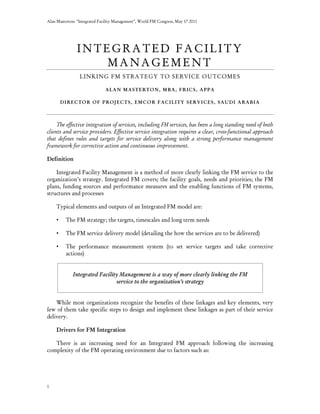Integrated Facility Management World Fm Congress May 17 Amasterton
- 1. Alan Masterton: ŌĆ£Integrated Facility ManagementŌĆØ, World FM Congress, May 17 2011 INTEGRATED FACILITY MANAGEMENT LINKING FM STRA TEGY TO SERVICE OUTCOMES ALAN MASTERTON, MBA, FRICS, APPA DIRECTOR OF PROJECTS, EMCOR FACILITY SERVICES, SAUDI ARABIA The effective integration of services, including FM services, has been a long standing need of both clients and service providers. Effective service integration requires a clear, cross-functional approach that defines rules and targets for service delivery along with a strong performance management framework for corrective action and continuous improvement. Definition Integrated Facility Management is a method of more clearly linking the FM service to the organizationŌĆÖs strategy. Integrated FM covers; the facility goals, needs and priorities; the FM plans, funding sources and performance measures and the enabling functions of FM systems, structures and processes Typical elements and outputs of an Integrated FM model are: ŌĆó The FM strategy; the targets, timescales and long term needs ŌĆó The FM service delivery model (detailing the how the services are to be delivered) ŌĆó The performance measurement system (to set service targets and take corrective actions) Integrated Facility Management is a way of more clearly linking the FM service to the organizationŌĆÖs strategy While most organizations recognize the benefits of these linkages and key elements, very few of them take specific steps to design and implement these linkages as part of their service delivery. Drivers for FM Integration There is an increasing need for an Integrated FM approach following the increasing complexity of the FM operating environment due to factors such as: 1
- 2. Alan Masterton: ŌĆ£Integrated Facility ManagementŌĆØ, World FM Congress, May 17 2011 ŌĆó number of management layers, where (in an IFMA study1) around 40% of FM departments had 4 or more layers ŌĆó increased spans of management control, where the ratio of managers to staff can be up to 1 to 15 ŌĆó complexity due to different definitions that can be used by different teams and departments A modern FM service requires effective integration of activities: ŌĆó To co-ordinate the FM service delivery model ŌĆó To avoid the cost of complexity (arising from the above organizational factors) ŌĆó And to deliver and demonstrate FM ŌĆśs value for money A modern FM service requires effective integration of activities to cope with increasing service complexity, maximize coordination and demonstrate service value for money The effective co-ordination of complex, FM services is especially important in regions such as the Middle East, where facilities can literally be the scale of a small city, with the services ranging from transport, housing, maintenance, food, environment, events and building controls. Serving Client Needs Client needs from the FM service are frequently around: ŌĆó service costs ŌĆó asset optimization ŌĆó service satisfaction While these needs and priorities are often clear at an executive level, conflicting needs often appear at lower levels of the client organization, which again can increase the complexity of the FM service delivery environment. Client needs relate frequently to service costs, asset optimization and service satisfaction 1 International FM Association, ŌĆ£Designing the FM organizationŌĆØ 2
- 3. Alan Masterton: ŌĆ£Integrated Facility ManagementŌĆØ, World FM Congress, May 17 2011 Integrated facility management developed from; increasing accountability for the service; increased service outsourcing and increased rate of change and needs in the client organizations. A key factor in the use of Integrated FM has been the rapid development of computer aided FM. This has allowed FM departments to handle higher volumes of tasks and cope with these greater levels of complexity. The EFS Integrated Service Delivery Model The service delivery model that we use in EFS is likewise based on an Integrated FM model. Again the intention is to control service complexity, by providing specific stages and frameworks for the service delivery. The key outputs in the EFS model are geared to meeting the FM strategy and service targets and cover: 1. Service Level Agreements to summarize client needs 2. Standard Operating Procedures to deliver the services 3. KPIs to set the and manage the performance targets 4. Continuous Improvement programs to meet and exceed the targets Structuring the Delivery Model In addition to structuring around key service outputs, it is necessary also to review and design the enabling functions; for example: ŌĆó how business services are delivered (labor intensive versus equipment intensive) ŌĆó who delivers them (in-house, outsourced or subcontract) ŌĆó where they are to be delivered (multi-site or single location) ŌĆó what work is best performed where (centralized versus decentralized) The key outputs in the EFS Service Delivery Model are geared to meeting the FM strategy and service targets; via SLAŌĆÖs, SOPs, KPIs and Continuous Improvement Designing these functions correctly, is especially important for delivery of large scale, multiple FM services 3
- 4. Alan Masterton: ŌĆ£Integrated Facility ManagementŌĆØ, World FM Congress, May 17 2011 This stage of designing the EFS model also considers; the service organization structure and required staff skills; service procedures and technology enablement; the rules, authority and governance and service targets and delivery timescales. Benefits of Integrated Facility Management Integrated FM helps the FM organization achieve service excellence by meeting client needs and priorities (for service effectiveness) and matching resources and costs to strategies and targets (for service efficiency). The FM service delivery model designs: ŌĆó what services we have to deliver; and ŌĆó how we will deliver them The performance measures within the integrated model communicate how well we are providing the service and how we can further improve the service. Overall, integrated FM ensures the benefits of optimal FM service through better design, linkage and implementation of the plans, processes and targets that meet the clientŌĆÖs FM strategy. 4




